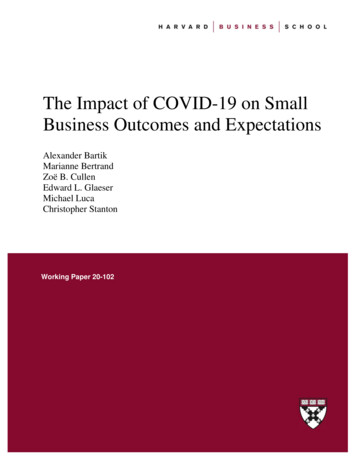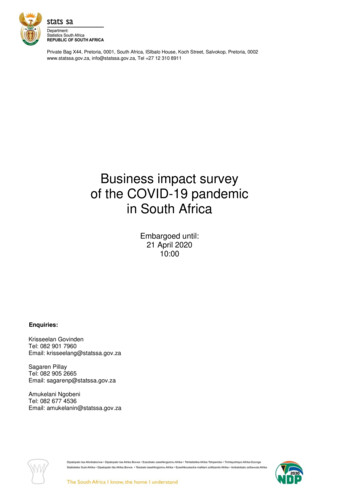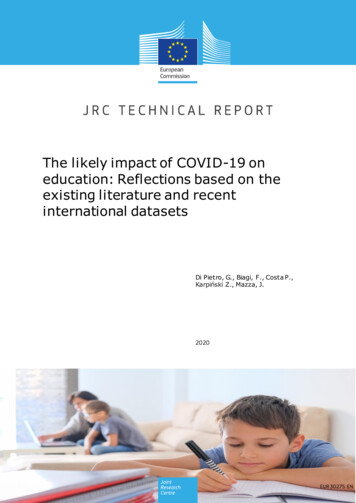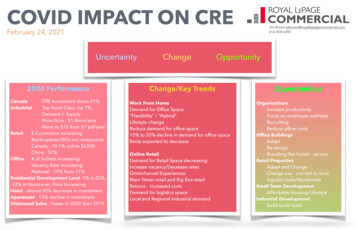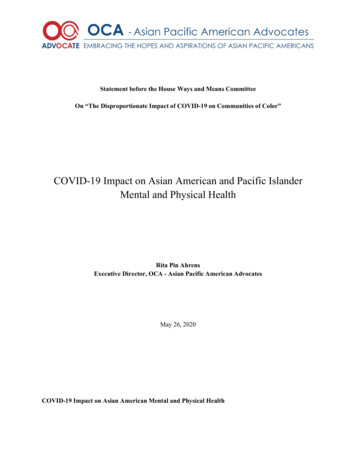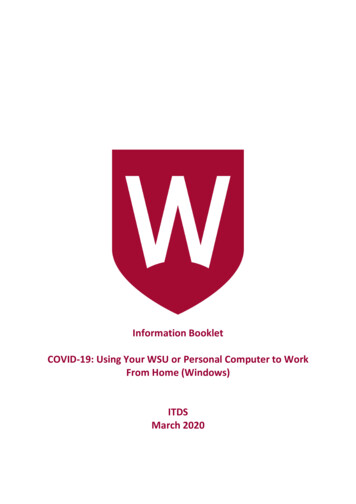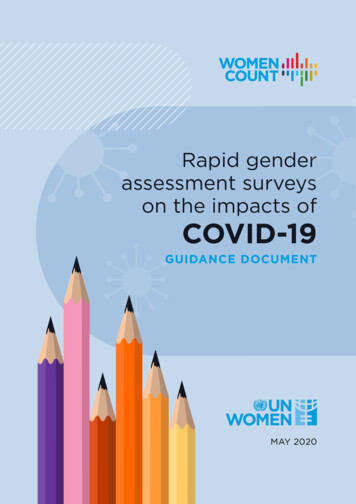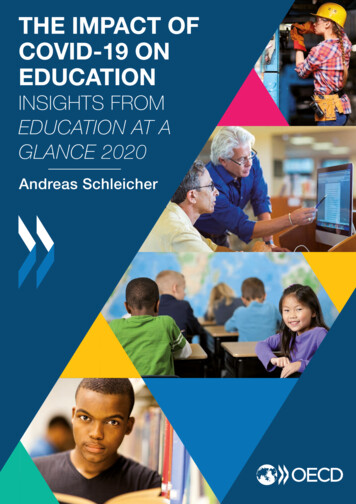
Transcription
THE IMPACT OFCOVID-19 ONEDUCATIONINSIGHTS FROMEDUCATION AT AGLANCE 2020Andreas SchleicherTHE IMPACT OF COVID-19 ON EDUCATION - INSIGHTS FROM EDUCATION AT A GLANCE 2020 @OECD 20201
2THE IMPACT OF COVID-19 ON EDUCATION - INSIGHTS FROM EDUCATION AT A GLANCE 2020 @OECD 2020
3The impact of COVID-19on education - Insights fromEducation at a Glance 2020This brochure focuses on a selection of indicators from Education at a Glance, selected for their particular relevance in thecurrent context. Their analysis enables the understanding of countries’ response and potential impact from the COVID-19containment measures. The following topics are discussed:p 06p 09The impact of thecrisis on educationCOVID-19 andeducationalinstitutionsPUBLIC FINANCING OF EDUCATIONIN OECD COUNTRIESINTERNATIONAL STUDENTMOBILITYp 12THE LOSS OF INSTRUCTIONAL TIMEDELIVERED IN A SCHOOL SETTINGp 14MEASURES TO CONTINUE STUDENTS’LEARNING DURING SCHOOL CLOSUREp 16TEACHERS’ PREPAREDNESS TOSUPPORT DIGITAL LEARNINGp 19WHEN AND HOW TO REOPENSCHOOLSp 21CLASS SIZE, A CRITICAL PARAMETERFOR THE REOPENING OF SCHOOLSp 23VOCATIONAL EDUCATION DURINGTHE COVID-19 LOCKDOWNTHE IMPACT OF COVID-19 ON EDUCATION - INSIGHTS FROM EDUCATION AT A GLANCE 2020 @OECD 2020
4IntroductionAs the world becomes increasingly interconnected, so docountry. These estimates assume that only the cohort currentlythe risks we face. The COVID-19 pandemic has not stoppedin school are affected by the closures and that all subsequentat national borders. It has affected people regardless ofcohorts resume normal schooling. If schools are slow tonationality, level of education, income or gender. But the samereturn to prior levels of performance, the growth losses willhas not been true for its consequences, which have hit thebe proportionately higher. Of course, slower growth from themost vulnerable hardest.loss of skills in today’s students will only be seen in the longterm. However, when considered over this term, the impactEducation is no exception. Students from privilegedbecomes significant. In other words, countries will continuebackgrounds, supported by their parents and eager and able toto face reduced economic well-being, even if their schoolslearn, could find their way past closed school doors to alternativeimmediately return to pre-pandemic levels of performance.learning opportunities. Those from disadvantaged backgroundsFor example, for the United States, if the student cohorts inoften remained shut out when their schools shut down.school during the 2020 closures record a corona-induced lossof skills of one-tenth of a standard deviation and if all cohortsThis crisis has exposed the many inadequacies and inequitiesthereafter return to previous levels, the 1.5% loss of future GDPin our education systems – from access to the broadband andwould be equivalent to a total economic loss of USD 15.3 trillioncomputers needed for online education, and the supportive(Hanushek E and Woessman L, forthcoming[1]).environments needed to focus on learning, up to themisalignment between resources and needs.The COVID-19 pandemic has also had a severe impacton higher education as universities closed their premisesThe lockdowns in response to COVID-19 have interruptedand countries shut their borders in response to lockdownconventional schooling with nationwide school closures inmeasures. Although higher education institutions were quickmost OECD and partner countries, the majority lasting atto replace face-to-face lectures with online learning, theseleast 10 weeks. While the educational community have madeclosures affected learning and examinations as well as theconcerted efforts to maintain learning continuity during thissafety and legal status of international students in theirperiod, children and students have had to rely more on theirhost country. Perhaps most importantly, the crisis raisesown resources to continue learning remotely through thequestions about the value offered by a university educationInternet, television or radio. Teachers also had to adapt towhich includes networking and social opportunities as well asnew pedagogical concepts and modes of delivery of teaching,educational content. To remain relevant, universities will needfor which they may not have been trained. In particular,to reinvent their learning environments so that digitalisationlearners in the most marginalised groups, who don’t haveexpands and complements student-teacher and otheraccess to digital learning resources or lack the resilience andrelationships.engagement to learn on their own, are at risk of falling behind.Reopening schools and universities will bring unquestionableHanushek and Woessman have used historical growthbenefits to students and the wider economy. In addition,regressions to estimate the long-run economic impact of thisreopening schools will bring economic benefits to familiesloss of the equivalent to one-third of a year of schooling forby enabling some parents to return to work. Those benefits,the current student cohort. Because learning loss will lead tohowever, must be carefully weighed against the health risksskill loss, and the skills people have relate to their productivity,and the requirement to mitigate the toll of the pandemic. Thegross domestic product (GDP) could be 1.5% lower on averageneed for such trade-offs calls for sustained and effective co-for the remainder of the century. The present value of the totalordination between education and public health authorities atcost would amount to 69% of current GDP for the typicaldifferent levels of government, enhanced by local participationTHE IMPACT OF COVID-19 ON EDUCATION - INSIGHTS FROM EDUCATION AT A GLANCE 2020 @OECD 2020
5and autonomy, tailoring responses to the local context. Severalbeen on the front lines in the response to the pandemic,steps can be taken to manage the risks and trade-offs, includingproviding essential services to society.physical distancing measures, establishing hygiene protocols,revising personnel and attendance policies, and investing inThroughout this crisis, education systems are increasinglystaff training on appropriate measures to cope with the virus.looking towards international policy experiences, data andanalyses as they develop their policy responses. The OECD’sHowever, the challenges do not end with the immediate crisis.publication Education at a Glance contributes to these effortsIn particular, spending on education may be compromised inby developing and analysing quantitative, internationallythe coming years. As public funds are directed to health andcomparable indicators that are particularly relevant to thesocial welfare, long-term public spending on education is atunderstanding of the environment in which the sanitary crisisrisk despite short-term stimulus packages in some countries.has unfolded. While the indicators in the publication EducationPrivate funding will also become scarce as the economyat a Glance date from before the crisis, this brochure putsweakens and unemployment rises. At tertiary level, the declinethese indicators into the context of the pandemic. It providesin the international student mobility following travel restrictionsinsights into its economic consequences for education, butis already reducing the funds available in countries wherealso the dynamics of reconciling public health with maintainingforeign students pay higher fees. More widely, the lockdowneducational provision. The policy responses presented in thishas exacerbated inequality among workers. While teleworkingbrochure cover key measures announced or introduced beforeis often an option for the most qualified, it is seldom possiblethe end of June 2020.for those with lower levels of education, many of whom haveTHE IMPACT OF COVID-19 ON EDUCATION - INSIGHTS FROM EDUCATION AT A GLANCE 2020 @OECD 2020
6The impact of the crisison educationPublic financing of educationin OECD countriesWhile the long-term impact of thecrisis is uncertain, the pandemic mayaffect public spending on educationas funds are diverted into the healthsector and the economy11%Economic pressuresGlobal economicactivity is expectedto fall by at least6% in 2020Some countries haveintroduced short-termsupport measures:Supplyof digitallearningdevicesof publicexpenditure wasdevoted to educationbefore the pandemic*Financialsupport tostudents andschoolsThe spread ofCOVID-19 hassent shockwavesacross the globeFunds forsafety andcleaningequipment*in 2017, on average across OECD countriesTHE IMPACT OF COVID-19 ON EDUCATION - INSIGHTS FROM EDUCATION AT A GLANCE 2020 @OECD 2020
7The spread of COVID-19 has sent shockwaves acrosssectors (including education, healthcare, social security andthe globe. The public health crisis, unprecedented in ourdefence) depend on countries’ priorities and the prevalencelifetimes, has caused severe human suffering and lossof private provision of these services. Education is anof life. The exponential rise in infected patients and thearea in which all governments intervene to fund, direct ordramatic consequences of serious cases of the diseaseregulate the provision of services. As there is no guaranteehave overwhelmed hospitals and health professionals andthat markets will provide equitable access to educationalput significant strain on the health sector. As governmentsopportunities, government funding of educational services isgrappled with the spread of the disease by closing down entireneeded to ensure that education is not beyond the reach ofeconomic sectors and imposing widespread restrictions onsome members of society. In 2017, total public expendituremobility, the sanitary crisis evolved into a major economicon primary to tertiary education as a percentage of totalcrisis which is expected to burden societies for years to come.government expenditure was 11% on average across OECDAccording to the OECD’s latest Economic Outlook, even thecountries. However, this share varies across OECD andmost optimistic scenarios predict a brutal recession. Even if apartner countries, ranging from around 7% in Greece tosecond wave of infections is avoided, global economic activityaround 17% in Chile (Figure 1).is expected to fall by 6% in 2020, with average unemploymentin OECD countries climbing to 9.2%, from 5.4% in 2019. In theHowever, government funding on education often fluctuatesevent of a second large-scale outbreak triggering a return toin response to external shocks, as governments reprioritiselockdown, the situation would be worse (OECD, 2020[2]).investments. The slowdown of economic growth associatedwith the spread of the virus may affect the availability ofAll this has implications for education, which dependspublic funding for education in OECD and partner countries,on tax money but which is also the key to tomorrow’s taxas tax income declines and emergency funds are funnelledincome. Decisions concerning budget allocations to variousinto supporting increasing healthcare and welfare costs.Figure 1. Total public expenditure on education as a percentage of total governmentexpenditure (2017)Primary to tertiary education%18Public transfers and payments to the non-educational private sectorDirect public expenditure on educational institutionsTotal public expenditure on education as a percentage of total government expenditure161412108640ChileSouth AfricaMexicoBrazilSwitzerlandNew ZealandIcelandCosta d KingdomArgentinaUnited StatesTurkeySwedenNetherlandsCanada2BelgiumOECD averageEstoniaFinlandPortugalAustriaEU23 iaRussian FederationSpainFranceCzech RepublicSlovak RepublicJapanHungaryLuxembourgItalyGreece21. Year of reference 2018.2. Primary education includes pre-primary programmes.Countries are ranked in descending order of total public expenditure on education as a percentage of total government expenditure.Source: Education at a Glance (2020), Figure C4.1. See Education at a Glance (OECD, 2020[3]) for more information and Annex 3 for notes(https://doi.org/10.1787/69096873-en).THE IMPACT OF COVID-19 ON EDUCATION - INSIGHTS FROM EDUCATION AT A GLANCE 2020 @OECD 2020
8Economic crises have put pressure on public budgets in theschool graduates who are unable to find work duepast. In some countries, this has led to reductions in publicto COVID-19 over the summer months. The Canadafunding for education. While cross-country comparisonsStudent Service Grant will also provide financial supportdo not show a strong relationship between spending onto students who do national service and serve theireducation and educational outcomes across OECD countries,communities during the pandemic crisis. The governmentdue to significant differences in the productivity of educationhas also announced plans to double student grantssystems, reducing spending without improving productivity isand broaden the eligibility for financial assistancelikely to negatively affect the quality of education. It may take(Trudeau, 2020[8]), as well as additional support in thea few years to see the effect of a crisis on education funding.form of scholarship funding extensions for studentsIn the aftermath of the last financial crisis, despite severeand postdoctoral researchers affected by the COVID-19budget cuts in all OECD countries, the majority continued topandemic (Ministry of Education, 2020[9]).increase public spending on education between 2008 and2009, with the first signs of a slowdown only appeared in 2010 Distance learning support measures announced byas austerity measures imposed cuts on education budgets inthe Italian government in March 2020 to equip schoolsabout one-third of OECD countries (OECD, 2013[4]).with digital platforms and tools for distance learning,lend digital devices to less well-off students, and trainHowever, the current crisis may affect education budgets moreschool staff in methodologies and techniques forquickly as public revenues decline sharply and
This brochure focuses on a selection of indicators from Education at a Glance, selected for their particular relevance in the current context. Their analysis enables the understanding of countries’ response and potential impact from the COVID-19 containment measures. The following topics are discussed: COVID-19 and educational institutions

